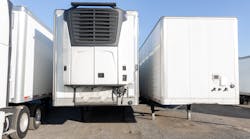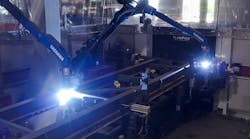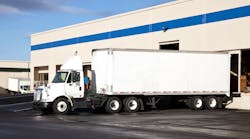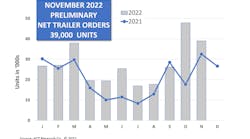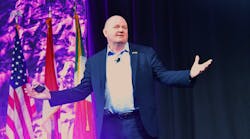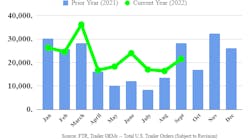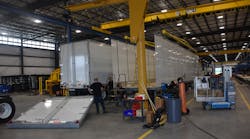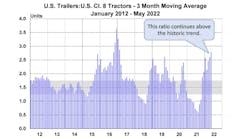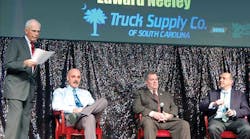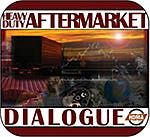TO expand on presentations given earlier in the day, Stu MacKay, president of MacKay & Company, moderated a distribution panel on the topic of “Branding, Internet, and e-Commerce: Challenges and Opportunities.”
MacKay felt the panel provided a good mix of aftermarket distribution because it featured a large, multi-location company, one that is heavy on the service and rebuild/reman sides, and a smaller, aggressive, rapidly growing independent.
The panelists were: Mike McKay, director of parts operations for Kenworth Sales Company; Edward Neeley, owner of Truck Supply Company; and Geoff Garafola, vice-president of Inland Truck Parts.
Q: Your take on the e-commerce presentation?
Neeley: From our perspective, we fly under the radar because we’re not that large. Our business model is the same as Mike and Geoff’s. It’s a matter of getting the customers what they want when they want it. You’ve got to know what you’re looking for when you go to the Internet. A lot of guys in our customer base come to the counter: ‘I need one of these and I need it quick.’ You give it to him right so he can get the truck up and running. The Internet’s OK. We use it to shop pricing. If an order is wrong three times and I give it to you right the first time, who wins? You’ve got to pay for knowledge. Nothing’s free. Most of our customers are local. We do very little national fleet business. Most of it is in regional dump fleets. We don’t do any LTL freight fleet business because the market is so beat up. We do construction, logging, and dump truck operations. That’s our bread-and-butter. We have strong relationships with a relatively tight customer base.
Garafola: We have multiple locations in 10 states, but it really comes down to the marketplace. The market we’re in, we know what the customer and his needs are. We think that business model works, and it’s obviously worked for a long time. It’d be silly to think things won’t change, especially with technology and e-commerce becoming prevalent. But I think e-commerce in the heavy-duty market will be pretty tricky. There’s a lot of information and support that goes along with parts, whether it’s technological information or cores or core returns. There are a lot of pieces that are fairly heavy, so freight is an issue. I don’t think we’re going to become irrelevant any time soon. I know there will be a shift, I just don’t know how impactful and fast. Large fleets are not a big part of our customer base. In some markets, they are just by virtue of what we can do for them in the market, but by and large, it’s just smaller guys who come into our shops.
Q: Let’s talk about private brands. In terms of Kenworth and TRP, who is the typical TRP customer?
McKay: Typically it’s the second or third owner—occasionally one of the national fleets when they’re retiring a truck or trading it. About the only thing I’ve ever touched in private brands are engine parts, with the exception of Detroit. Freightliner owns Detroit, but Cat and Cummins and everything else I do on the engine side is all genuine.
Q: Do other Kenworth dealers you might interface with have the same kind of TRP businesses?
McKay: The bulk of us are TRP. TRP has been a good product line. Currently it’s about 7% of our total mix. So today, it’s not huge but it does have potential. We are averaging 3-5% growth per year over the last five years.
Q: Edward, you’re heavily service-focused, as well as parts. Is there any activity at all other than national brand parts?
Neeley: I guess you have to define what private brands are. You look at the private brands they were talking about this morning. We try to put back what comes on the truck. We give them the longevity. A lot of guys remember what that first turn was on that truck. You can convince them pretty easily that that’s the product they need to go back to. We have a lot of owner-operators. They’re price conscious. They walk in and want that $7 shoe. We don’t sell it. It’s just not going to happen. If our name’s on the line, we’re going to put on something we’re going to stand behind. Either you want a guy standing looking at you when it breaks in half or a guy who will stand behind you willing to take the heat if something happens. We’re an HDA member. We use a lot of Meritor. We’re a big Meritor house.
Garafola: One thing that really resonated with me: It was said that we all have a brand regardless of what brands we sell. Our companies are our brands. At Inland, that’s the stock we put into our brand. It’s a total experience for the customer. The information we give them—the availability and things that make the transaction acceptable to the customer—that’s the Inland brand. And that is embodied in what we sell. Sometimes it’s easy with remanufactured products. We build and back those. The content to those is transparent to the customer. It’s really the finished product that they’re getting. They’re also coming to us for boxed products. But the way we market, present, and sell that is first and foremost the Inland brand. It’s a high-quality brand, not a value brand or low-cost brand. The solution we provide is the best we think for our customers. We have a high-quality product we’re selling to them, and the secondary brand underneath our overarching Inland is sort of irrelevant—not to everybody but to our customers it is. We do get customers who want this brand or that brand, and if we don’t have it, they choose not to do business with us. It’s incumbent on us to convince them of what we’ve done and the solution we’re trying to provide. But at the end of the day, we want to build the Inland brand. And we do that with good partners, good service, and a great experience for the customer.
Q: How has your parts business changed in the last five years? What impact has it had on the way you run that operation?
McKay: That’s kind of a tough question. The biggest change I see coming probably affects the larger metropolitan stores in terms of the people we’re attracting today as employees. We don’t have a lot of people coming into our industry as parts professionals for their livelihood. My kids are a perfect example. When you ask them what they want to be when they grow up, it has something to do with computers. That’s all they care about. Every kid wants to be a computer programmer. We struggle to find those kids in the 18-25 range that have a work ethic and are thinking about any type of career and not if you are just this mid-term stop to their next job.
Q: Western European companies are actively organizing and promoting apprentice programs for even kids at the high school level, getting them to develop fairly early. You’re right. Every kid wants to be the computer kid. But there are other opportunities. Exposure to those opportunities earlier to some of these kids apparently is paying off in some of the Western European countries.
Garafola: You do have a lot of knowledge exiting not only at our company but also the industry in the next decade. We try to augment that. It’s not going be half as effective but we’re building our systems to sort of emulate information that older, experienced guys may have. We still get the customer the right part and right ancillary parts they need that someone with experience would automatically know—cross-reference items or keyword searches would hopefully take the place of that exodus of information from the company. Also, we try to build the company to attract people. We have a dedicated training facility, which is a major investment for a relatively small company. But it’s a stake that says we want people. We want to hold onto people. It’s a 100% employee-owned company, and we think that’s attractive for people entering the workforce.
Q: Where do you look? Do you look at the trade schools?
Neeley: We’re looking at the high school level and even middle school level. A lot of these kids in our areas are at job fairs. We always try to participate, take a truck or something to get their interest up. We are actively pursuing that.
Q: Would you want to reach more customers or have faster turns on reman product by selling online?
Garafola: I think the implication in that is that we’d sell them outside our marketplace online, and I don’t think that’s a good thing for us. At least at this point in time. I think we perform best and deliver our brand promise best when it’s in the market where we reside and service it. Although more turns are attractive, I don’t think we’d want to do it at the sacrifice of servicing or selling outside of our marketplaces.
Q: How are proprietary parts changing your service and parts organization and customer support?
McKay: The propriety content is continuing to grow. I think all manufacturers are becoming more vertically integrated, trying to get more proprietary content. I don’t think it’s a secret that the more proprietary content we have on a vehicle, the better our margins look, the closer we tied that customer to us, because then we become the source of procurement for all those proprietary parts, and I think that’s the difficult portion when you look at enabling a FindItParts or somebody like that. You then take that proprietary content out of dealers who are paying for that proprietary content and open it up to a marketplace, and that could potentially devalue the product.
Q: So as your business has transitioned from a Kenworth dealer offering at one point in time Cat, Detroit Diesel, and Cummins to offering PACCAR and Cummins, has that narrowed the focus on your parts operations and probably service operations as well?
McKay: It’s definitely narrowed it. I wish Cat was still in the game because they had a great product, with the exception of about two years. It gives the customer more choice. I think we’re limiting some choices. Not that there’s anything wrong with the Cummins product, but we are limiting the choices of the customer. ♦
_______________________________________
This story was based on presentations at the recent Heavy Duty Aftermarket Dialog sponsored by the Heavy Duty Manufacturers Association and MacKay & Company. For information about next year’s even contact HDMA (www.hmda.org) For more information regarding MacKay & Company, visit www.mackayco.com.
